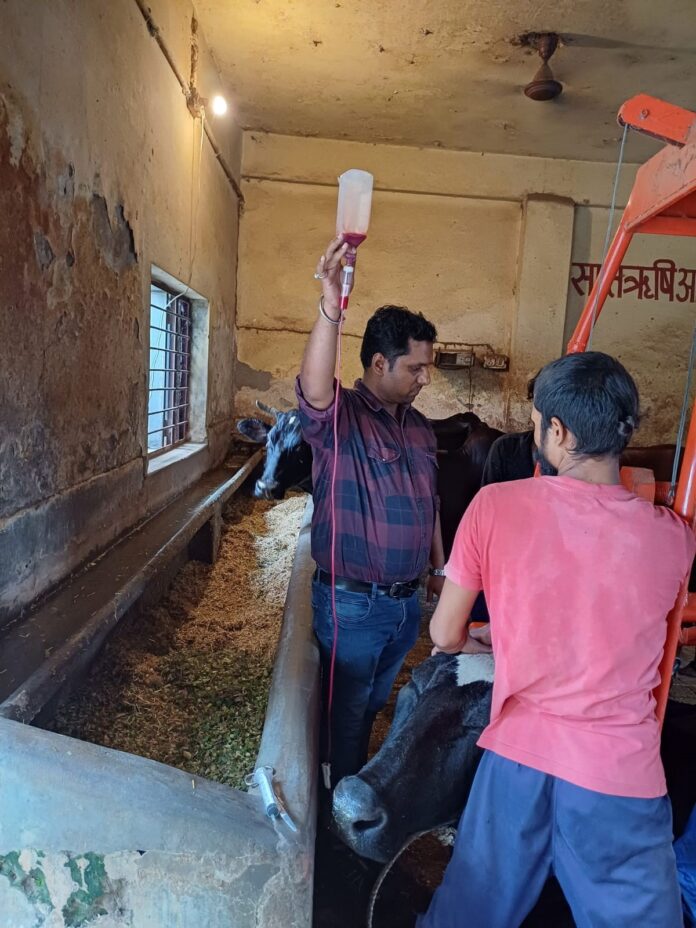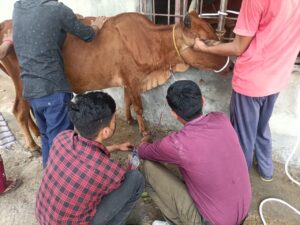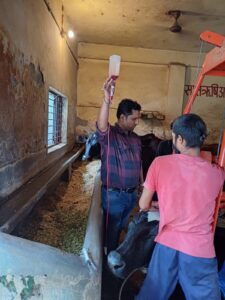Blood Transfusion in Dairy Cattle- You Need to Know
Dr Amit Kumar
Veterinary Officer
Government Veterinary Hospital, Shyampur-249204 Dehradun Uttarakhand
Introduction
Whole Blood transfusions have become an important tool in veterinary critical care and emergency Veterinary medicine (Weingart et al. 2004). A proper transfusion guideline, with the use of blood typing and crossmatch- ing procedures, and careful monitoring, minimize the risk of an adverse reaction and maximize the benefits of transfusion. Some times in filed conditions for the veterinary doctor its is necessary to transfusion in anemic animal. Its very difficult, time taking, and stressful to anemic animals. Fresh whole blood (WB) is composed of RBCs, white blood cells (WBCs), platelets, all the co- agulation factors, albumin and immunoglobulins (Chiaramonte 2004). Domestic animal have most complex blood group system with 11 groups like A, B, C, F, J, L, M, R, S, T, Z. But many does not have antibodies against other blood group antigens until encountered with previous transfusion. Transfused RBCs only survive for 2-4 days as compared to a normal erythrocyte life for 160 days. These two to four days enough to allow endogenous haemtopoesis to fill the deficit. Total Blood volume in cattle is 7-8% of body weight that is normal blood volume in adult cow is 55-57ml per kg body weight. Healthy adult animal can donate upto 10-15ml of blood per Kg body weight without any harm to animal. One thing must be remember that no more than 25% of total blood volume should be collected from the donar animal at a time.
Cross Matching
A crossmatch is performed prior to transfusion of blood. The purpose of this cross match is find out the antibodies in the donar blood. Mainly two type of cross matching is performed.
- Major Crossmatch- This procedure is crucial in preventing transfusion reactions, such as hemolysis (destruction of red blood cells) due to incompatible blood. It helps match the donor and recipient blood types and identify any antibodies that could cause a reaction.
- Minor Crossmatch- Minor cross-matching focuses on compatibility between the donor’s plasma (containing antibodies) and the recipient’s red blood cells. The objective is to confirm that the recipient’s red blood cells won’t be attacked by antibodies in the donor’s plasma.
Selection of Donar
Only animal is good health should be selected as donar but healthy animal is difficult to define but certain parameter like physical condition, previous disease history, some simple test should be done before selection.
- Age and Weight of donar animal – animal should not to old and not to young, animal should not be in underweight.
- Donar Appearance- appear to be in good health 2. should not be febrile, and suffering from a persistent cough. 3. rule out malnutrition or any debilitating condition 4. Mucous membrane not pallor 5. Rule out for enlarged lymph nodes 6.
- Illness- Animals with a history of recent infection: defer for 15 days following full recovery and cessation of any therapy, including antibiotics etc.
- Vital Parameters- Rectal Temperature and pulse should be in range.
- Pregnancy and Lactation Animals- Generally pregnant animal must be avoids for selection. Dry Animal should be given to priority.
Pic.2 Collection from donar Cow
Collection of Blood
Sodium Citrate:- its ready to use available in the medical Shop. 100ml of 3.8% sodium citrate solution per 1L of blood. Blood collection in Uro bag. Place halter on donor cow and tie the head to the side and up to ensure that the jugular vein is ex- posed for good access to vein. Clean the collection area around the jugular vein.
Blood Transfusion
Receiving animal place into the Cattle crush. Fixed the halter on cow and tie head securely to the upside to expose the jugular vein. Prepare over the vein area and clean with Antiseptic solution. Hook the blood bag high on the crush and Place catheter or wide bore needle in jugular vein. Allow the blood to run in, slowly at first then after a short period of time if there is no evidence of transfusion reaction, increase the rate of infusion. Monitor for transfusion reactions like respiratory changes, swelling of the face, trembling, oedema etc. than stop for some time and given antihistamine.
Pic. 3 Transfusion to Recipient Cow
Transfusion Guidelines *
| Product | Volume | Frequency | Indications |
| Fresh whole blood | 12 to 20 ml/kg | q. 24 h | anemia, platelet & factor replacement |
| Packed red cells | 6 to 10 ml/kg | q. 12 to 24 h | anemia |
| Platelet rich plasma | 6 to 10 ml/kg | q. 8 to 12 h | platelet dysfunction, thrombocytopenia |
| Fresh and fresh frozen plasma | 6 to 12 ml/kg | q. 8 to 12 h | coagulation factor deficiencies, vWD, DIC, hypoproteinemia |
| Frozen plasma | 6 to 12 ml/kg | q. 8 to 12 h | hypoproteinemia |
| Plasma cryoprecipitatea | 1 unit/10 kg | q. 4 to 12 h
(as needed) |
hemophilia A (factor VIII deficiency)
fibrinogen deficiency von Willebrand disease |
| Cryosupernatant | 6 to 12 ml/kg | q. 8 to 12 h | hemophilia B (factor IX deficiency)
factor VII, X, or XI deficiency vitamin K deficiency, hypoproteinemia |
References
- WEINGART C, GIGER U AND KOHN B. 2004. Whole blood transfusions in 91 cats: a clinical evaluation. J Feline Med Surg 6: 139–148.
- CHIARAMONTE D. 2004. Blood-component therapy: se- lection, administration and monitoring. Clin Tech Small Anim Pract 19: 63–67.
- * https://www.vet.cornell.edu/animal-health-diagnostic-center/laboratories/comparative-coagulation/clinical-topics/transfusion-guidelines





